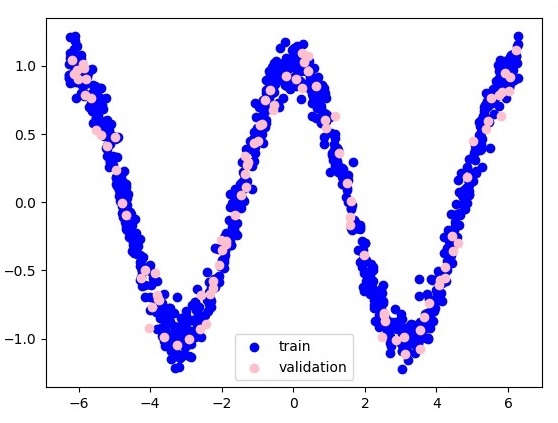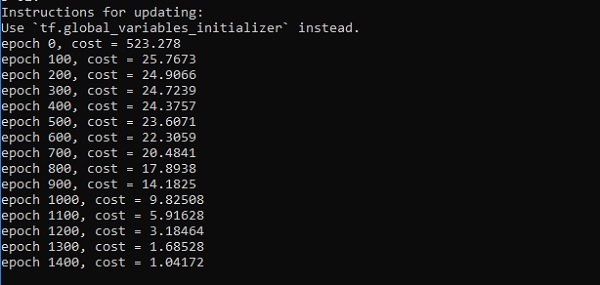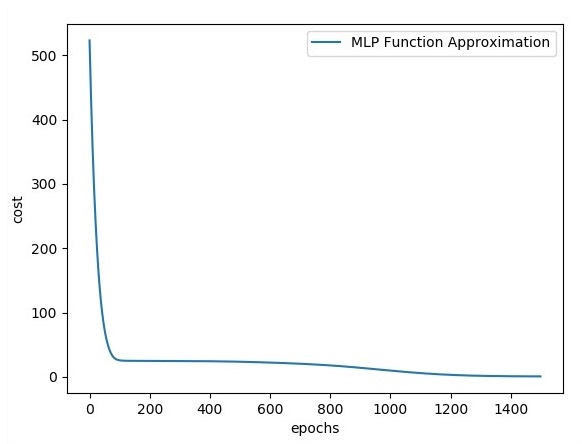- 入门教程
- ANN教程
- CNN教程
- RNN教程
关注我们

在本章中,无涯教程将专注于从x和f(x)的已知点集中学习的网络,由单个隐藏层将构建此简单网络。
解释感知器隐藏层的代码如下所示-
#Importing the necessary modules import tensorflow as tf import numpy as np import math, random import matplotlib.pyplot as plt np.random.seed(1000) function_to_learn=lambda x: np.cos(x) + 0.1*np.random.randn(*x.shape) layer_1_neurons=10 NUM_points=1000 #训练参数 batch_size=100 NUM_EPOCHS=1500 all_x=np.float32(np.random.uniform(-2*math.pi, 2*math.pi, (1, NUM_points))).T np.random.shuffle(all_x) train_size=int(900) #训练给定集合中的前 700 个点 x_training=all_x[:train_size] y_training=function_to_learn(x_training) #训练给定集合中的最后 300 个点 x_validation=all_x[train_size:] y_validation=function_to_learn(x_validation) plt.figure(1) plt.scatter(x_training, y_training, c='blue', label='train') plt.scatter(x_validation, y_validation, c='pink', label='validation') plt.legend() plt.show() X=tf.placeholder(tf.float32, [None, 1], name="X") Y=tf.placeholder(tf.float32, [None, 1], name="Y") #first layer #神经元数=10 w_h=tf.Variable( tf.random_uniform([1, layer_1_neurons],\minval=-1, maxval=1, dtype=tf.float32)) b_h=tf.Variable(tf.zeros([1, layer_1_neurons], dtype=tf.float32)) h=tf.nn.sigmoid(tf.matmul(X, w_h) + b_h) #output layer #Number of neurons=10 w_o=tf.Variable( tf.random_uniform([layer_1_neurons, 1],\minval=-1, maxval=1, dtype=tf.float32)) b_o=tf.Variable(tf.zeros([1, 1], dtype=tf.float32)) #建立模型 model=tf.matmul(h, w_o) + b_o #最小化成本函数(模型 - Y) train_op=tf.train.AdamOptimizer().minimize(tf.nn.l2_loss(model - Y)) #开始学习阶段 sess=tf.Session() sess.run(tf.initialize_all_variables()) errors=[] for i in range(NUM_EPOCHS): for start, end in zip(range(0, len(x_training), batch_size),\ range(batch_size, len(x_training), batch_size)): sess.run(train_op, feed_dict={X: x_training[start:end],\Y: y_training[start:end]}) cost=sess.run(tf.nn.l2_loss(model - y_validation),\feed_dict={X:x_validation}) errors.append(cost) if i%100 == 0: print("epoch %d, cost=%g" % (i, cost)) plt.plot(errors,label='MLP Function Approximation') plt.xlabel('epochs') plt.ylabel('cost') plt.legend() plt.show()
以下是功能层近似的表示-
来源:LearnFk无涯教程网

这里,两个数据以W的形式表示。两个数据是:训练和验证,它们以不同的颜色表示,如在图例部分中可见。


祝学习愉快!(内容编辑有误?请选中要编辑内容 -> 右键 -> 修改 -> 提交!)
Spring Cloud 微服务项目实战 -〔姚秋辰(姚半仙)〕
好记忆不如烂笔头。留下您的足迹吧 :)
 《TensorFlow入门教程》
《TensorFlow入门教程》 